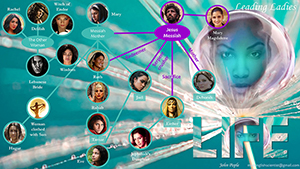 |
| Leading Ladies |
| This series is dedicated to in-depth exploration of the fascinating lives of the primary female characters we encounter in the Bible. Whether morally good or evil, we look at the powerful influences these women had, necessarily “Leading Ladies” all, even from their positions of social disadvantage. Most importantly, we see that several of them (Deborah, Jael, Ruth, Esther) each fulfil one of the various roles of Messiah, in foreshadowing cameo. Various glittering jewels of interest can be discovered from them, including seeing how Mary Magdalene rises in precedence above the male apostles; solving the surprising destinies of both Jephthah’s daughter and Delilah; and illuminating new takes on some of their characters, including Rachel, the Bride of Solomon’s Song, and the Witch at Endor. |
| ------------------------------------------------------------------------------------------------------------------------------------------------ |
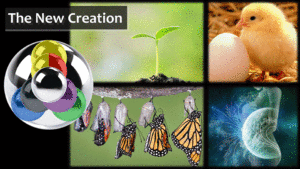 |
| The New Creation |
Understanding the Creation pattern as God’s Signature and seeing it:
• In the natural creation (Genesis)
• In the spiritual creation (Jesus)
• In God’s development of His nation (Exodus)
• In Jesus’ development of His nation (7 churches)
• In our discipleship, to be created with God’s Name in our foreheads |
| ------------------------------------------------------------------------------------------------------------------------------------------------ |
 |
| The King Who Fell |
1. The Mysterious Song: What is the Song of Songs actually about?
2. Siren Song from Lebanon: Solving the identity of the leading couple and seeing the Bride’s character and effect on the King
3. Lilies, Myrrh & Doves: The three main symbols’ meaning & effect on the plot
4. Standing Guard in Vain: Telling dynamics between the King & Bride interacting with the Daughters of Jerusalem & Watchmen
5. Here There Be Giants: The Preacher’s confession; Proverbial Wives; Spiritual Twins; & Jesus’ victory |
| ------------------------------------------------------------------------------------------------------------------------------------------------ |
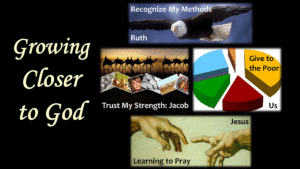 |
| Growing Closer to God |
- Ruth: Recognize My Methods. God’s pattern of Sheltering Wings, and how Ruth sees them. How David and even Jesus learn from Ruth
- Jacob: Trust My Strength. The mystery of Jacob’s wrestling with the angel. What really happened, and how God both gave, took away, and restored Jacob’s blessing
- Us: Give to the Poor. To grow closer to God, we must do what God does
- Jesus: Learning to Pray. The joy of hope versus the poison of expectation. Real case studies in prayer |
| ------------------------------------------------------------------------------------------------------------------------------------------------ |
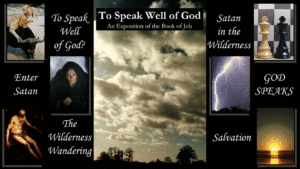 |
| To Speak Well of God |
1. To Speak Well of God? Challenges of Job: the fractious interface between theology and reality. The philosophy of justice shows an unaccountable God ≠ uncaring God. Learning to speak well of God amidst affliction
2. Enter Satan: Evidence suggests Satan is human pride, hosted by the three friends. Debate now seen as struggle between the Satan and the righteous man. Can now see God as caring, as He prepares even Satan’s salvation
3. The Wilderness Journey: The three friends are children of Abraham, Job is a ‘Gentile.’ Thus ‘Satan’ is also from line of Christ. Job is during wilderness wanderings: thus the debate is Satan vs righteous man in the wilderness – like Christ
4. Satan in the Wilderness: The debate has three levels: observations, interpretations, condemnations. The friends had misunderstood what Moses said. Elihu is ‘John the Baptist’ type, clears Job’s unwise subpoena, and enables Job to hear God
5. GOD Speaks: 1st speech is natural creation, 2nd is spiritual. God answers Job’s questions, when it seems He hasn’t, pointing out Job’s failure to control the ultimate wild beast: pride. Job’s brilliance in understanding God’s speeches
6. Salvation: God’s judgment reveals Christ as God’s Word. Job a priest of Melchizedek. Job now serves from faith, not fear, repents OF dust and ashes. The suffering of a righteous man brings salvation to unrighteous men |
| ------------------------------------------------------------------------------------------------------------------------------------------------ |
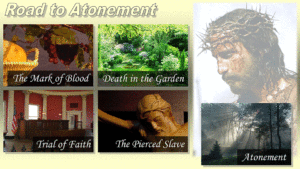 |
| Road to Atonement |
Concept: We walk the same road the Master walked to, and beyond, the cross
1. The Mark of Blood (Upper Room): Why Jesus disrobes to wash feet. Absence of bread & wine from John is deliberate: showing salvation is from actions beyond the meal
2. Prayer in the Garden (Gethsemane): Why did Jesus have to die? The Servant Ruler. Learning to pray. Peter’s swordplay vs. true swordplay. Why the road to atonement is finding the road for others
3. Trial of Faith (Praetorium): Betrayal by more than Judas. Peter’s vision of Judgment Day. The Lord is still on trial: we defend or scorn him. Why Jesus’ death didn’t pay the price for sin
4. The Pierced Slave (Calvary): What Jesus meant in shouting from the cross. God did NOT turn His face away. Ex 21 explains the pierced slave, death value 30 shekels and salvation from the horns of the ox. The Cross as a doorway, not a destination
5. Atonement: (Empty Tomb): Covenant of the crushed & cultivated. Lev 14 explains atonement of the leprous house. Heaven is God’s presence, Heaven on Earth. Emmaus: Jesus accepts invites to reside |
| ------------------------------------------------------------------------------------------------------------------------------------------------ |
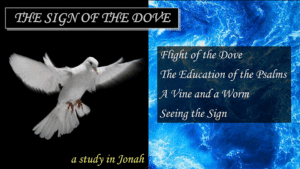 |
| The Sign of the Dove |
1. Flight of the Dove (Jon 1): Jonah, of Zebulun. His bigotry and stubborn refusal to preach to the Gentile aggressor Assyria. Conundrum of Jonah’s sacrifice: right or wrong? Jonah’s flight to Joppa ironically brings salvation to the Gentile sailors, fulfilling Jacob’s prophecy
2. The Education of the Psalms (Jon 2): Jonah’s prayer. Offering thanks for salvation before he is saved! Prayer is entirely from the Psalms, the context of each quote reveals a hidden prayer, arguably more beautiful than the spoken one
3. A Vine and A Worm (Jon 3-4): “Mercy comes to him who mercy sees”: Nineveh is forgiven immediately, yet for Jonah it was three days. Vine and worm event was a realized parable from God teaching Jonah about the need for empathy and forgiveness
4. Seeing the Sign (NT): The Sign of the Dove at Jesus’ baptism was the miracle the Pharisees’ requested. Restoration of Joppa, the city beautiful. Jonah’s realizes he was the Temple for those outside God’s covenant, as does Peter, called Son of the Dove, also a precedental prophet to the Gentiles. We must be the ‘view to mercy’ for those outside covenant hope |
| ------------------------------------------------------------------------------------------------------------------------------------------------ |
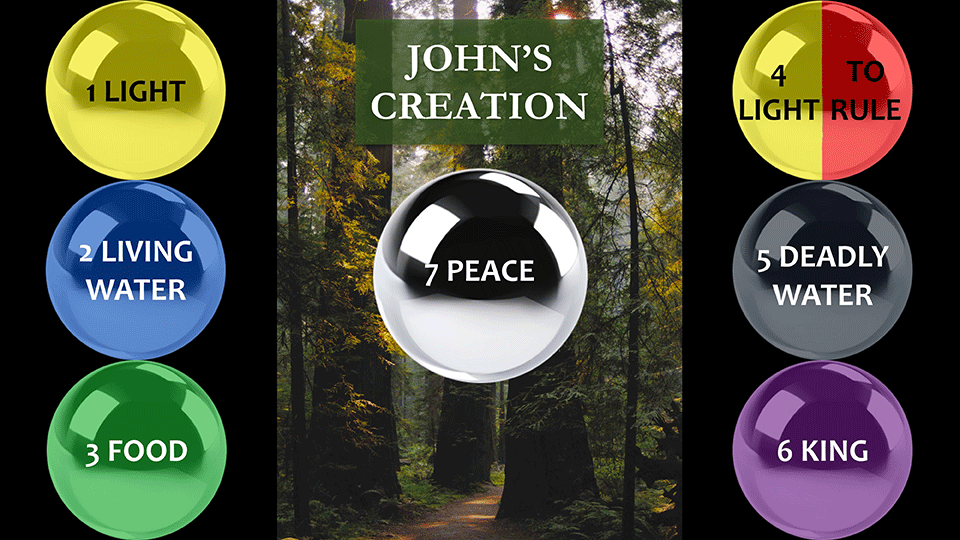 |
| John's Creation |
John’s Gospel is deliberately arranged to present Jesus Christ according to the Creation sequence; to reveal the pre-eminence of the Spiritual Creation
· Day 1 (Jn 1-3:21): Jesus presented as the Light of the World. Light represents understanding, gospel reveals who can see the revelation and who are blind to it, groping in darkness
· Day 2 (Jn 3:22-5): Jesus presented as the life-giving ‘Waters Above.’ Those who encounter him are raised up to life: centurion’s servant, impotent man at Bethesda, Samaritan woman
· Day 3 (Jn 6): Jesus presented as the Bread of Life. Those who follow him are nourished by a meal of bread and fish
· Day 4 – c.f. Day 1 (Jn 7-12): Jesus presented as the ‘Light to Rule.’ Repeat of Jesus as the light of the world, now a governing role. Repeat of those who can see and those who are blind, now coupled to responsibility and judgment
· Day 5 – c.f. Day 2 (Jn 13-19): Jesus presented in the deadly ‘Waters Beneath.’ Leviathan rises: all betray Christ: the Seed of the Woman is killed
· Day 6 – c.f. Day 3 (Jn 20-21): Jesus is the Ruling Man of the New Creation. Titles “Rabbi” and “Son of God” are upgraded to “Rabboni” and “God.” Those who remain with him are nourished with a meal of bread and fish |